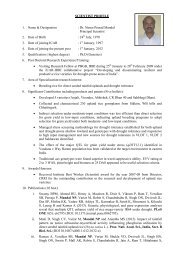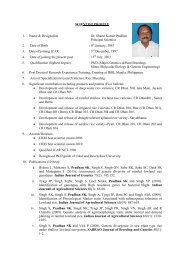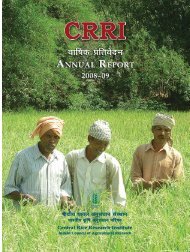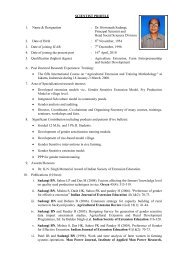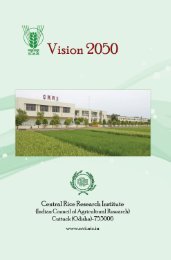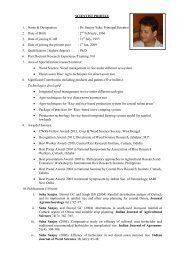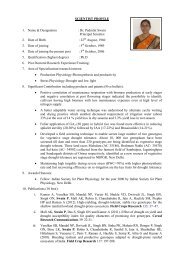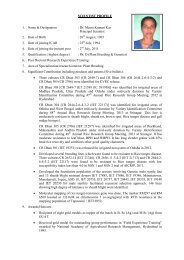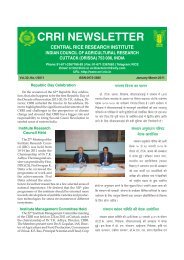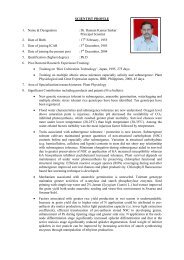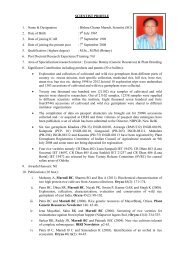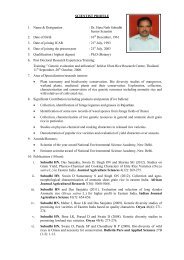Central Rice Research Institute Annual report...2011-12
Central Rice Research Institute Annual report...2011-12
Central Rice Research Institute Annual report...2011-12
Create successful ePaper yourself
Turn your PDF publications into a flip-book with our unique Google optimized e-Paper software.
Strategic <strong>Research</strong> on Pathogens/<br />
Pest Population Dynamics, Crop<br />
Losses and Forecasting<br />
Studies on Pest/Natural Enemy Population<br />
Dynamics<br />
Studies on off-season biology and resurgence<br />
of major rice insect pests<br />
White backed planthopper (WBPH) was found to<br />
complete its life cycle successfully on the ratoon plants<br />
of rice variety TN1 and succeeded to next generation in<br />
the harvested field having stagnate water and served<br />
as its off-season habitat. WBPH completed two generations<br />
in 35 days in ratoon rice recording more than 90<br />
% survival. Off-season biology of WBPH studied on<br />
eight weeds, indicated that nymphs could develop only<br />
on Echinocloa colona and become adults.<br />
Three granular insecticides viz., Carbofuran, Cartap,<br />
Phorate and three microbial insecticides involving Verticillium<br />
lecani, Metarhizium anisoplae and Beauveria<br />
bassiana were tested under field condition for their possible<br />
role in inducing leaf folder (LF) resurgence. A<br />
maximum of 34.5% leaf damage was observed under<br />
carbofuran treatment compared to 23.3% in control indicating<br />
resurgence of LF. Application of Cartap significantly<br />
reduced LF incidence to 8.2% leaf damage.<br />
Seasonal prevalence of rice insect pests<br />
recorded through light traps<br />
YSB population reached a small peak of 774 moths<br />
in 14 th standard meteorological week (SMW) of 2011<br />
and remained low throughout the wet season. It<br />
reached a small peak of 384 moths week -1 in the 40 th<br />
SMW and another with 434 moth week -1 in the 44 th<br />
SMW and declined thereafter. This population was too<br />
small as compared to other years (excepting 2011).<br />
Based on the duration of life cycle it may be presumed<br />
that the parent brood emerges about six weeks before<br />
the peak emergence pesticide application during 34 th<br />
and 38 th SMW can protect rice crop from the attack of<br />
the peak brood.<br />
Population of Chilo sp. followed a similar pattern<br />
and reached a peak of 265 moths in the 6 th SMW and<br />
another peak of 42 moths in the 44 th SMW. Population<br />
of YSB was predominant (95.00%) while Chilo species<br />
represented 4.0% and other stem borers only 1.0%. Leaf<br />
folder population increased in January-2011 and<br />
reached a peak in 7 th SMW with 152 moths week -1 and<br />
then declined. During wet season, it reached another<br />
peak of 90 moths week -1 in 40 th SMW in October.<br />
Case worm population during dry season started<br />
increasing from the 1 st week of January and reached<br />
peak of 3<strong>12</strong> moths week -1 in the 6 th SMW. It appeared in<br />
good numbers in the wet season and reached a peak of<br />
580 moths week -1 in the 39 th SMW. Green leaf hopper<br />
population started increasing from September (32 nd<br />
SMW), remained high throughout September and October.<br />
It reached a peak of 28,449 in the 43 rd SMW.<br />
Light trap catch of Cnaphalocrocis medinalis (Guenee)<br />
at <strong>Central</strong> <strong>Rice</strong> <strong>Research</strong> <strong>Institute</strong>; Cuttack from 1990 to<br />
2009 was analyzed to study the population trend of the<br />
pest over the years. During 1990 – 1999, a major peak<br />
was observed at 19 th SMW with two small peaks at 10 th<br />
and 16 th SMW. In the wet season, the peak pest population<br />
was observed at 42 nd SMW and two small peaks at<br />
38 t h SMW and 46 th SMW. During 2000-2009, in the dry<br />
season, one major peak was observed at 7 th SMW with<br />
two small peaks at 14 th and 18 th SMW. In the wet season,<br />
the major peak was observed during 45-46 SMW<br />
and another three small peaks were observed corresponding<br />
to 38-39, 42-43, 49-50 SMW. The mean annual<br />
leaffolder population from 1990 to 1999 and 2000<br />
to 2009 indicated that over the past few years, the magnitude<br />
and number of peaks in the season has increased.<br />
Earlier (1990 to 1999), there were two peaks of leaffolder<br />
population in the dry season and grossly two peaks in<br />
the wet season, whereas, in the recent years three small<br />
peaks in the dry season and four peaks in the wet season<br />
were evident. The study indicated that leaffolder<br />
population has increased in recent years.<br />
78 CRRI ANNUAL REPORT 2011-<strong>12</strong>



